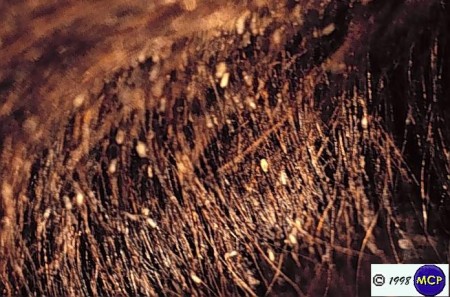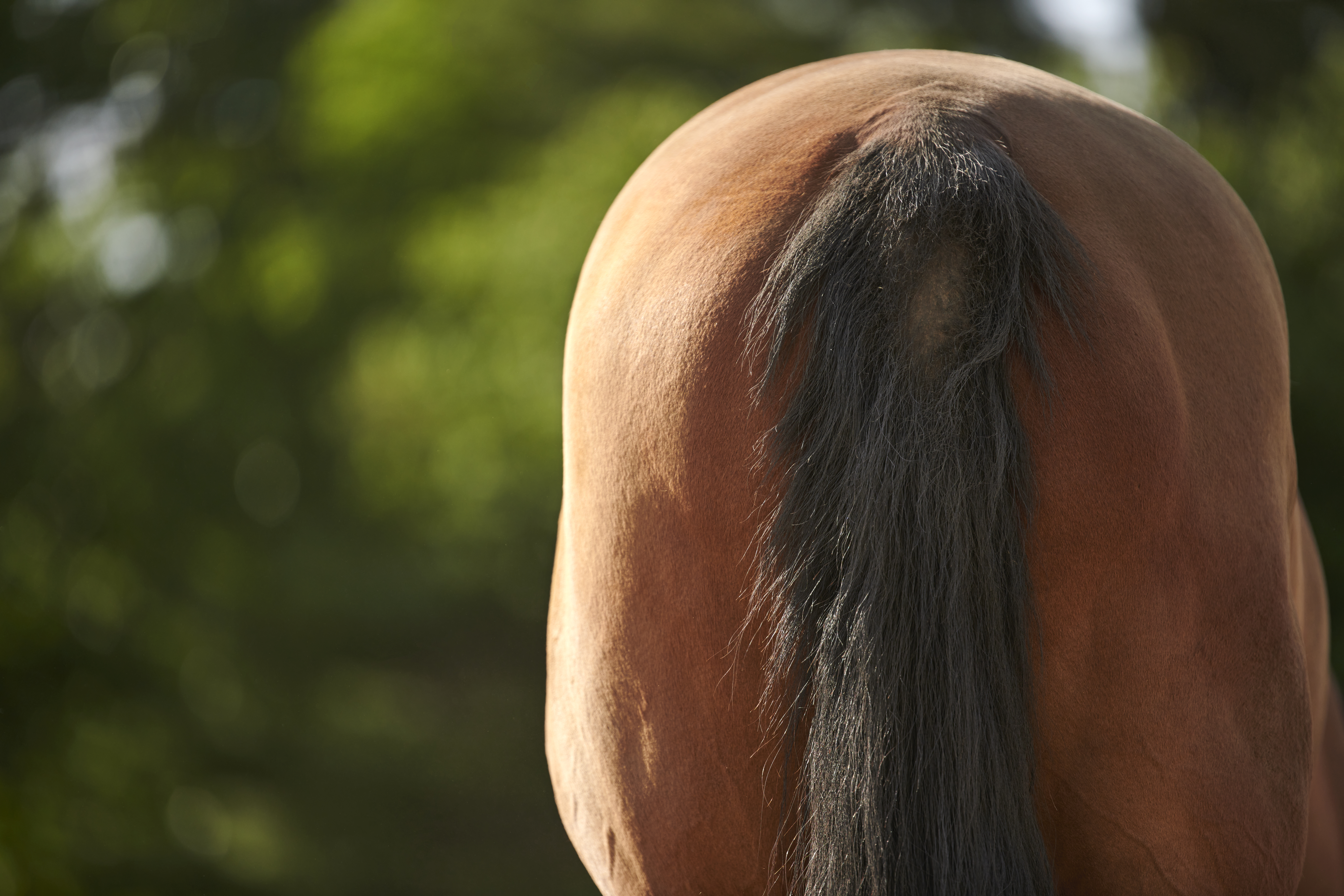Prevention & Treatment of Lice in Horses
Updated March 22, 2024 | By: Jamie Whittenburg, DVM

When people think of lice, oftentimes our minds go to images of kids with itchy heads and frantic school nurses. Many horse owners do not know that, in fact, lice can also affect horses. Lice infestations (technically termed pediculosis) can be an issue for some horses.
You may suspect a lice infestation if your horse seems very itchy with irritated, red skin and areas of hair loss. It is essential to recognize, diagnose, and treat lice as they can severely affect a horse’s quality of life.
What are Horse Lice?
Lice are small insects that cannot fly and are parasitic, meaning they depend on a host organism for survival. To the untrained eye, these tiny specks could be mistaken for dandruff, shavings, or dust particles. But they are active and can be seen moving through the hair.
For horses, there are two major categories of lice:
- Haematopinus asini: bloodsucking lice.
- Damalinia equi: biting or chewing lice that feed on skin cells and debris.

Both types may migrate all over the horse’s body and often found on the head, neck, mane, and tail. However, bloodsucking lice are commonly found on the mane, base of the tail, fetlocks, and inner thighs, while chewing lice are often seen on the forehead, neck, back, and flanks.
Life Cycle
Lice undergo a three-stage life cycle, beginning with an egg (called a nit), maturing into a nymph, and finally, becoming an adult. All three stages of the louse (singular form of lice) occur on the host, in this case, the horse.
The adult female louse will lay her eggs onto the hair shaft and attach each one with a sticky substance. After one to three weeks, the eggs will hatch into the larval stage, called nymphs. These mature into adults in two to four weeks. Adults will live on the host for about a month.
Signs Your Horse May Have a Lice Infestation

Lice can infect any horse, but an infestation is more common in those who are sick, injured, or immunosuppressed. Signs of horse lice could include:
- Itching - the primary sign of lice, which may manifest as a horse biting or rubbing himself against walls, fences, and other objects. Intense itching may lead to irritated, red skin and patchy hair loss.
- Weight loss and restlessness.
- Anemia – if the infestation has been going on for some time.
Lice are often found during the winter or early spring months.
Dealing with Lice in Different Horse Breeds
Horses with thick, long hair coats may be more prone to having lice. Breeds such as Clydesdales, Friesians, and Shires have long, feathered hair on their legs and may be more susceptible. Daily grooming and paying close attention to the skin, especially in areas of longer hair, is an important tool to catch lice as soon as possible.
Transmission of Horse Lice
Usually, lice are transmitted from one horse to another through direct contact. Lice may also be transmitted from horse to horse via infested tack, grooming brushes, and other equipment. This can happen at a small facility or large show barn.
Lice are species-specific, meaning that horse lice are not a threat to humans. However, like equipment, humans can act as a mode of transportation and transmission of lice between horses.
Factors That May Contribute to Lice Infestation in Horses
- Long hair coat
- Poor body condition
- Weakened immune system
- Overcrowded, dirty facilities
Diagnosis
Typically, lice can be diagnosed with a visual exam as they can seen on the horse’s skin and when parting the hair of the mane, forelock, and tail. An insect can be taken and identified under a microscope, too.
Treatment Options

A thorough and aggressive treatment plan must be implemented when a lice infestation is diagnosed. An infestation can be incredibly uncomfortable for a horse and, if left untreated, can lead to weight and hair loss, secondary skin infections, and self-mutilation. Delaying treatment (or not treating at all) also enables the parasites to spread and affect other horses.
To begin, your horse should be bathed with a shampoo that contains an insecticide (such as permethrin) with a repeat shampooing two weeks later to ensure any newly hatched lice are eradicated. Consult your veterinarian about which product is best for your individual horse, as well as the proper dosage and treatment duration.
Insecticides to control lice may be available as spray or wipe-on formulas. Be sure to wear gloves and eye protection while using any of these products.
Your veterinarian may also recommend an oral dewormer, such as ivermectin or moxidectin, if your horse has bloodsucking lice. Deworming can improve overall health and the ability for horses to rid themselves of other types of parasites (internal and external).
Preventing and Managing Lice on Horses
- Since lice are contagious, any horse that’s been diagnosed or in contact with a horse that has lice should be quarantined.
- Infested horses should be treated and isolated until they are free from lice.
- Any equipment (like brushes, saddle pads, buckets, blankets, tack, etc.) used on an infested horse must be thoroughly cleaned and treated with an insecticide before it’s used on a non-infested horse.
Supporting a Healthy Immune System
A horse with a well-functioning immune system will fare much better than a stressed or sick horse when faced with lice. Reducing stress, ensuring a high-quality diet, and proper care will all make for a healthier horse. Keeping your horse up to date on regular parasite control, vaccinations, and wellness exams can help prevent lice from finding your horse as a suitable host. With the advice of your veterinarian, you may wish to add antioxidants, probiotics, prebiotics, and other ingredients to your horse’s diet to aid in supporting the immune system.
Key Takeaways and Additional Resources
Lice can be troublesome pests for horses, causing intense itching and discomfort. Transmission of lice can happen quickly, so it is important to treat an infested horse as soon as possible and keep them separated from other, non-infested horses.
Watch these videos to learn about how you can sanitize things at the barn:
- Learn how to sanitize a stall at the showgrounds.
- Understand how frequently to clean and disinfect equipment like pitch forks, brushes, and buckets.
- Put on your “germ goggles” when it comes to sharing tack and grooming supplies between horses.